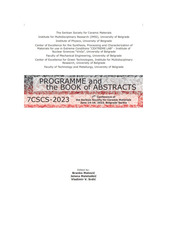Приказ основних података о документу
Quantum sensors for gas mixture detection
| dc.creator | Branković, Goran | |
| dc.creator | Branković, Zorica | |
| dc.creator | Vojisavljević, Katarina | |
| dc.creator | Malešević, Aleksandar | |
| dc.creator | Marinković Stanojević, Zorica | |
| dc.creator | Počuča-Nešić, Milica | |
| dc.creator | Mitrović, Jelena | |
| dc.creator | Rostovtsev, Yuri | |
| dc.date.accessioned | 2023-08-22T06:16:56Z | |
| dc.date.available | 2023-08-22T06:16:56Z | |
| dc.date.issued | 2023 | |
| dc.identifier.isbn | 978-86-80109-24-4 | |
| dc.identifier.uri | http://rimsi.imsi.bg.ac.rs/handle/123456789/2088 | |
| dc.description.abstract | Numerous methods have been utilized for molecular detection, including optical, calorimetric, acoustic, and techniques based on changes in electrical properties, such as metal oxide semiconductor sensors [1,2]. Recent research endeavors have led to a significant rise in sensitivity, detecting parts per billion (ppb) [3], but the challenges of selectivity and cross-sensing remain crucial areas of investigation. Developing a gas sensor with high selectivity to efficiently analyze multi-gas mixtures would be of great significance, with potential applications in various fields such as technology, environmental control, biology, and medicine. Quantum sensors are a promising new technology for the detection of gas mixtures. They offer a number of advantages over traditional methods, including high sensitivity, selectivity, and response time. In the presentation, we propose a new method based on the resonant interaction of dipole molecules with ac fields, in the presence of a dc electric and magnetic field that creates Zeeman and Stark splitting of molecular levels specific to certain molecules, ensuring selectivity [4]. In this talk, we present some preliminary experimental results obtained for the molecule NO on the use of quantum sensors for the detection of gas mixtures. Our results demonstrate the potential of quantum sensors for a variety of applications in gas sensing. We believe that quantum sensors have the potential to revolutionize the field of gas sensing. 1. X. Liu, et al. Sensors (Basel), 12 (2012) 9635–9665. 2. S. Lakkis, R. Younes, Y. Alayli, M. Sawan, Sensor Review, 34 (2014) 24–35. 3. J.-H. Lee, J.-Y. Kim, J.-H. Kim, S. S. Kim, Sensors (Basel), 19 (2019) 726. 4. Z. Branković, Y. Rostovtsev, Sci. Rep., 10 (2020) 1537. | sr |
| dc.language.iso | en | sr |
| dc.publisher | University of Belgrade, Institute for Multidisciplinary Research | sr |
| dc.relation | info:eu-repo/grantAgreement/MESTD/inst-2020/200053/RS// | sr |
| dc.rights | openAccess | sr |
| dc.source | 7th Conference of the Serbian Society for Ceramic Materials, 7CSCS-2023, June 14-16, 2023, Belgrade, Serbia | sr |
| dc.subject | Metal oxide semiconductor sensors | sr |
| dc.subject | Quantum sensors | sr |
| dc.subject | High selectivity | sr |
| dc.subject | Resonant interaction | sr |
| dc.subject | Gas mixtures | sr |
| dc.title | Quantum sensors for gas mixture detection | sr |
| dc.type | conferenceObject | sr |
| dc.rights.license | ARR | sr |
| dc.citation.spage | 43 | |
| dc.identifier.fulltext | http://rimsi.imsi.bg.ac.rs/bitstream/id/5503/bitstream_5503.pdf | |
| dc.identifier.rcub | https://hdl.handle.net/21.15107/rcub_rimsi_2088 | |
| dc.type.version | publishedVersion | sr |

